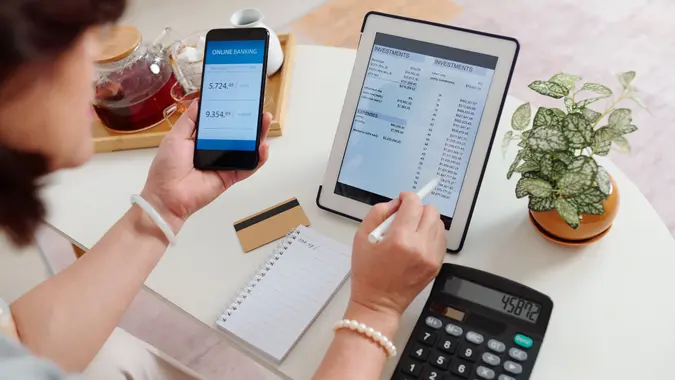How To Apply for SNAP Benefits

Commitment to Our Readers
GOBankingRates' editorial team is committed to bringing you unbiased reviews and information. We use data-driven methodologies to evaluate financial products and services - our reviews and ratings are not influenced by advertisers. You can read more about our editorial guidelines and our products and services review methodology.

20 Years
Helping You Live Richer

Reviewed
by Experts

Trusted by
Millions of Readers
The Supplemental Nutrition Assistance Program (SNAP) — formerly known as food stamps — is administered by the United States Department of Agriculture (USDA) and is the largest federal nutrition assistance program in the country. Approximately 40 to 42 million people receive benefits monthly.
To be eligible for SNAP benefits, you must meet your state’s requirements, including gross income limits. States can also take other resources into account, like the money you have in your bank, to decide if you qualify. To get started with an application form, you can visit your local chapter or apply online with the required documentation.
Here’s what individuals and families need to know about SNAP eligibility, applying for SNAP, and what happens after submitting your SNAP application.
Quick Take: Is SNAP Changing Soon?
Before you submit your SNAP application, contact your local office. Depending on your state, you may be able to submit a food stamp application online, in person or by mail, and may need to be interviewed before being approved for SNAP benefits. Here are a few key takeaways as to what changes could be happening to the program in 2025 and beyond:
- According to the Center on Budget and Policy Priorities, a proposed House reconciliation bill would cut nearly $300 billion from SNAP, which would be the largest cut in history, impacting millions of low-income families and potentially ending SNAP in some states.
- This would mean that beginning October 1, 2027, states would be responsible for 5% of benefit costs, shifting some financial responsibility from the federal government.
- Proposals to expand SNAP’s existing work requirements could further reduce access to benefits for some individuals and families.
- Some proposals, like reversing the 2021 Thrifty Food Plan (TFP) update, could lead to an immediate and significant reduction in SNAP benefits.
Am I Eligible for SNAP?
In order to qualify for SNAP, individuals must be able to meet a few requirements. Applicants must live in the state in which they apply for SNAP and meet certain income limits.
A SNAP household is defined as everyone who lives together and purchases and prepares meals together. This includes spouses and most children under age 22. Generally, if an institution gives you most of your meals, you would not be eligible for SNAP benefits. However, there are exceptions when it comes to child support or for elderly and disabled persons.
Eligible low-income individuals and families may receive SNAP benefits through an EBT card. Each month, SNAP benefits are added to your card to use when you shop for groceries. This card may be used to purchase eligible food for the household from authorized food retailers.
The SNAP eligibility resources page outlines a table of SNAP income eligibility limits per household size. The household must meet the gross and net income limits described in this table. Otherwise, the household is not eligible for SNAP and may not receive benefits.
Households with an elderly or disabled person are only required to meet the net income limit. Households in which all members receive Temporary Assistance for Needy Families (TANF) or Supplemental Security Income (SSI) may be considered categorically eligible for SNAP due to predetermined eligibility for other means-tested programs.
There are also work requirements for SNAP eligibility. The four primary requirements are registering for work, not voluntarily quitting a job or reducing hours, taking a job if offered and participating in employment and training programs if assigned by the state. Able-bodied adults without dependents are required to work at least 20 hours per week to receive SNAP benefits for more than three months in a 36-month period.
Special groups not subject to these requirements include children, seniors, pregnant women and individuals exempt for physical or mental health reasons. Students ages 18 through 49 who are enrolled in college at least part-time are not eligible for SNAP unless they meet specific exemptions.
How Do I Apply for SNAP?
SNAP applications must be submitted to your local state agency in the state where you currently live. A member of your household must contact the state agency directly to apply for SNAP. Find your nearest local SNAP office by reviewing the interactive map provided by the SNAP State Directory of Resources. Please note that the USDA Food and Nutrition Service (FNS) does not process SNAP applications.
If you do not have easy access to the internet, you may find local offices in the state or local government pages of telephone books. These offices may be listed under titles including “Food Stamps,” “Social Services,” “Human Services” and “Public Assistance.” You can find the address of your local state agency and visit the office or call your state’s toll-free SNAP Information hotline.
What Happens After My SNAP Application Is Submitted?
Once you submit your SNAP application, your state agency or local SNAP office will process it. You will receive a notice within 30 days stating whether you are or are not eligible for SNAP benefits. Applicants will need to complete an eligibility interview over the telephone or in person and provide verification of the information provided in the application.
Eligible individuals will receive SNAP benefits based on the date of their application submission. SNAP benefits will be issued through an EBT card. This card works like a debit card and automatically loads benefits into your account each month. You may use an EBT card at authorized food stores and retailers to purchase groceries.
Where Can I Find More Information About SNAP?
Reach out to your local SNAP office if you have additional questions regarding SNAP benefits or your specific case information. You may also call SNAP’s toll-free information hotline at 800-221-5689.
Caitlyn Moorhead contributed to the reporting for this article.
More From GOBankingRates
 Written by
Written by  Edited by
Edited by 

























